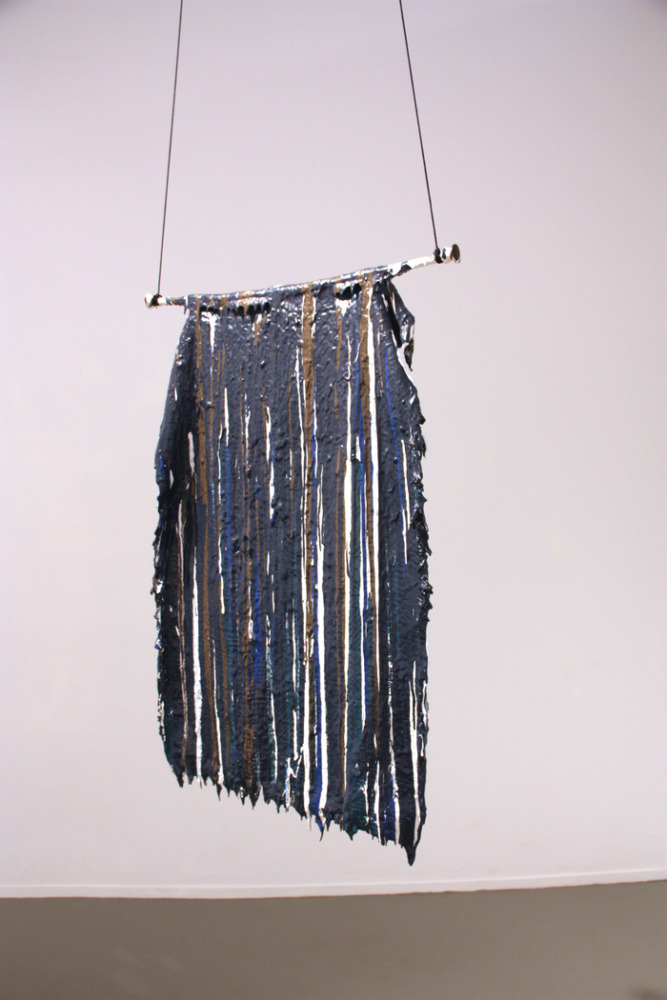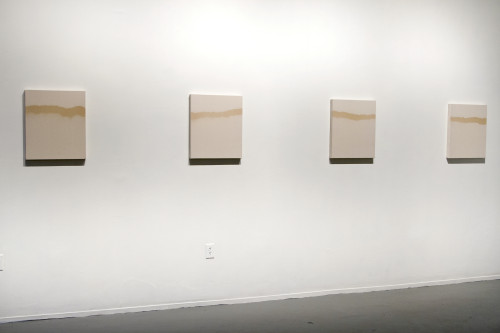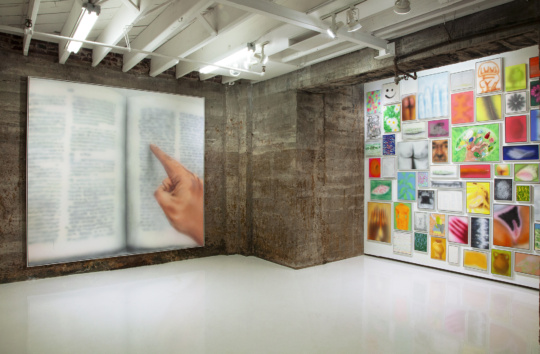
In the midst of a peaceful demonstration on the campus of UC-Davis in 2011, the Occupy movement experienced an abuse of power and authority. Commonly known as the “pepper spray incident,” university police lieutenant John Pike sprayed a line of seated protestors on the campus quad. The incident provoked widespread scrutiny on the militarized tactics of the police force and the (mis)uses of pepper spray for crowd control and self-defense. Incredibly painful, pepper spray causes inflammation of the airways and temporary blindness. It is, nevertheless, legal in most states, including Florida, and was the material of choice for artist Anthea Behm in her recent body of work.
This material’s odor is perceptible upon entering the two-person exhibition: Resistance Abstract. On view through June 27 at F.L.A. Gallery in Gainesville, Anthea Behm and Lisa Iglesias both tackle politically charged subject matter in painting, sculpture, and video. Behm’s seven, unprimed stretched canvas “portraits,” each measuring 17 by 20 inches, were made together with one can of Pepper Spray Stream, referencing the UC-Davis incident. The canvases were placed side by side, and the artist mimicked Pike’s action in applying—as the title states—2.14 seconds of spray in a horizontal line. The resultant mark also registers the temporality of the spray: the visual/formal (depth of saturation) and sensory effects (odor) fade over time.
Behm’s large canvas, titled 60 seconds, was made with four cans at 15 seconds each and two types of spray that generate a unique textural effect. As with the “portraits,” the spray soaked into the raw canvas immediately upon application, while a gel version—thicker and more viscous in consistency—sat on top of the canvas. Together, the mixture creates a bold set of unruly vertical lines.
In the exhibition space, 60 seconds is in direct formal conversation with Iglesias’s Covered Ground, which was made by repeatedly dripping latex paint over a found tapestry of the Florida state flag. Covered Ground’s aggressive vertical composition and the unconventional and untidy use of materials are relevant to the political source/ground of the work. Made over the course of 2013 and into 2014, the work’s production time also contrasts with that of Behm’s painting, which was literally made in one minute.

Iglesias’s Capitalism and Freedom is a stack of concrete slabs, interspersed with pages ripped from Milton Friedman’s book of the same name. Part of the Chicago School of Economics, Friedman was an economist who supported privatization and tax cuts that was implemented by the Reagan Administration. The development of these neoliberal policies has contributed to rising inequality, and increasingly abstract social relations. The concrete stack is similar in scale and height to a pedestal. Yet it is unable to be used in a conventional way, as it appears structurally unstable and ready to topple at any moment. The work takes this copy of Friedman’s book out of circulation. The concrete slabs (what might act as place holders for material reality) obscure the neoliberal theoretical argument. The two must be taken together; the materiality cannot be abstracted or deferred, as it is in the economist’s model.
This selection of works suggests that abstraction may differ dramatically from our formalist expectations. Rather than remain rooted in aesthetic concerns, these art objects are complicated by anti-capitalist ambition. In a recent conversation with the artist Behm stated “I am interested in pepper spray as a materialization of the problems inherent in current political and economic systems.” This might also “…link the current return to abstraction with a historical moment of the Cold War era—when President Ronald Reagan implemented neoliberal policies, and Abstract Expressionist paintings (from MoMA, New York) were instrumentalized to promote the ‘freedom’ of American capitalism—what Nelson Rockefeller referred to as ‘free enterprise painting.’”
Throughout the exhibition, abstraction is complicated, its formal autonomy repeatedly confronted by content and context. Despite this shared concern, Behm and Iglesias produce very different works. Utilizing painting and sculpture—a departure from their usual media—their divergent approaches register important possibilities for abstraction, in both aesthetic and social terms. The exhibition promotes a way to negotiate an increasingly abstract society through two historically loaded forms of art making. Ultimately, it questions the “disconnect” between abstract material interests and the material of concrete realities.

(All photos: Alisson Bittiker)






